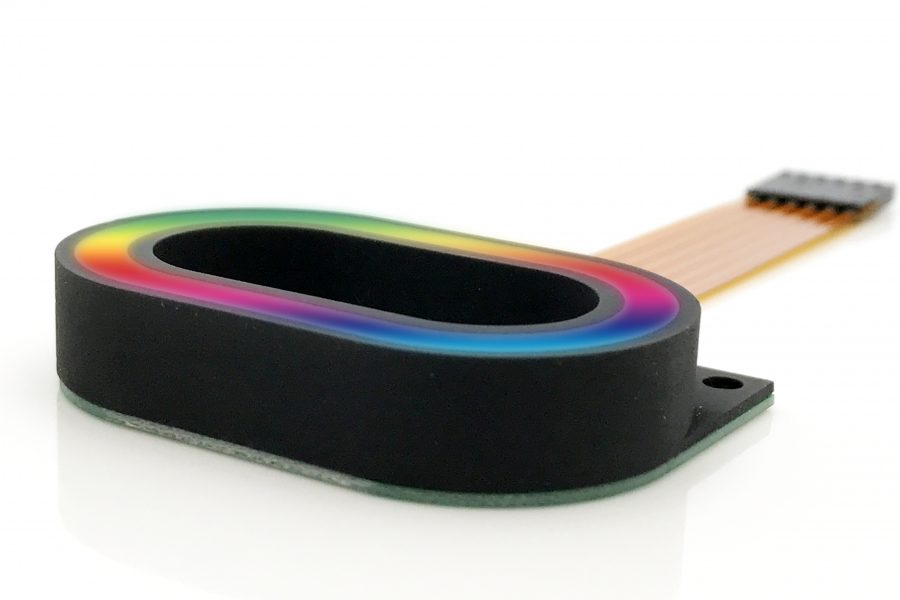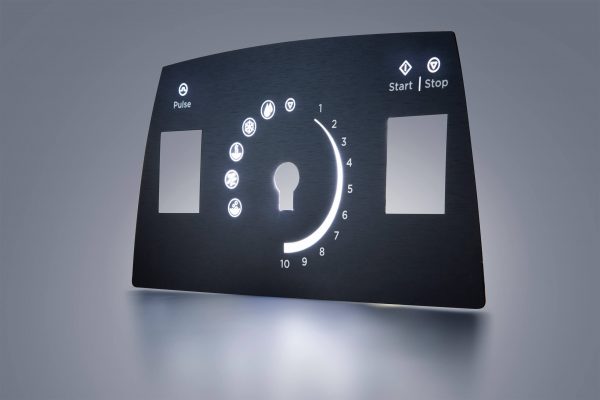What’s New in Addressable LEDs

LEDs are perhaps the simplest and most common technique used in backlighting. These low-cost, low-power, highly reliable light sources come in a range of colors and intensities, so there’s a great deal of freedom from a design perspective. Circuit cards with embossed LEDs can be layered under translucent graphic layers, or side-firing LEDs can be strategically placed around the buttons of a membrane switch assembly. The problem is that these are single-point light sources and can create hot spots within an interface.
Enter RGB LEDs, which mixes red, green, and blue lights together to create millions of colors on the spectrum, providing a stark contrast to a single-color LED light. The industry has advanced the technology again; creating addressable LEDs that can be programmed to run independently from one another, resulting in dynamic, multi-colored light displays. Engineers in virtually every industry are using addressable LED technology in their products for a simple reason: it impresses users. It gives engineers and product users more control, more flexibility, and a higher degree of end-user satisfaction. The past decade has seen a whirlwind of advances in the addressable RGB LED space, benefitting companies who choose to take advantage of this new technology.
Ability To Create Proper White Hues
Standard RGB LEDs create white by combining the output from red, green, and blue LEDs, which doesn’t allow users much control over the temperature of the white output.
Next-generation addressable WRGB (white + red, blue, and green) LEDs have an additional white LED chip integrated, allowing programmers to precisely control the white output. This is especially important in products that require a proper white, such as task lighting. Because of the additional features, WRGB LEDs can add cost, but also result in a much more capable product. For basic RGB colors with no requirement for a proper white, a standard RGB LED use is generally more cost-effective.
The controllers for WRBG LEDs also vary from the controllers for traditional RGB LEDs. RGB+W lighting controllers have five outputs: one for each color and one for power. Since RGB LEDs have one less chip, they only require four. The PWM signal, which is a common way to adjust the brightness of each LED, also has to be different to control the white part of the LED in RGB+W.
Seamless Light Blending
LEDs have a tendency to create hot spots on a user interface if the light is not blended properly, which can leave an unfinished look, especially in areas that require multiple LED lights. The area directly above and around the LED is lit brightly, while areas further away from the LED are dimmer.
Since addressable LEDs work together to create a colorful light display, seamless light blending helps the product look more high-tech and professional by hiding the individual explosions of color. This can be achieved by using a light-guiding layer (LGL). Optimizing the distance wherever possible between the light source and area to backlit is the key to achieving a uniform and consistent lighting result.
More Affordable Options and Use Across Industries
When addressable LEDs were first released into the market, only a handful of companies could afford to integrate them into their products. As the technology has become more available, the price has also decreased, making this special feature more accessible.
Organizations across industries are now incorporating addressable RGB LEDs into their product. Addressable RGB LEDs are commonly used in the interior lighting design, computer and gaming space, but we have recently seen military and DoD contractors integrating them into their products as well.
Better Lighting Across a Large Surface Area
Individual LEDs work well for small and unique buttons. However, when a selective backlighting solution is needed for a larger surface area or multiple buttons, multiple RGB LEDs placed strategically and combined with Light-Guide Layers or custom made diffusers generate the desired color or sequence of colors with different levels of brightness across the desired area.
When engineers search for high-tech custom backlighting solutions, they turn to JN White®. Contact us to discuss the best backlighting solution for your next project – we’d love to help!
More from Ken
Even the most capable technologies suffer if they fail to take into account the user experience (UX). When designing a user interface, membrane switch assembly, or graphic overlay, backlighting must work in conjunction with the design of the solution and…
Although they create great end-user experiences, backlighting technologies can be a real challenge for engineers and manufacturers.







